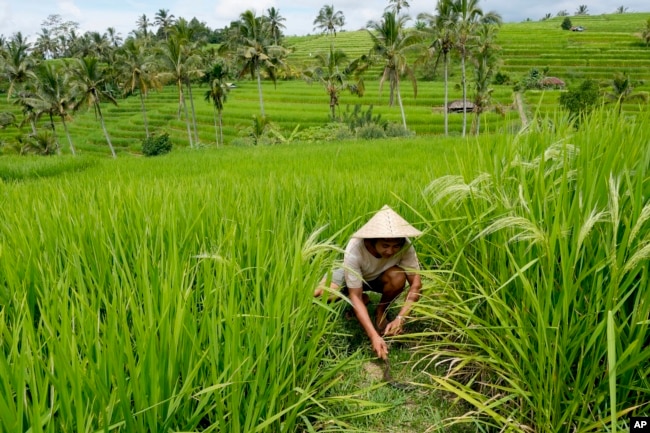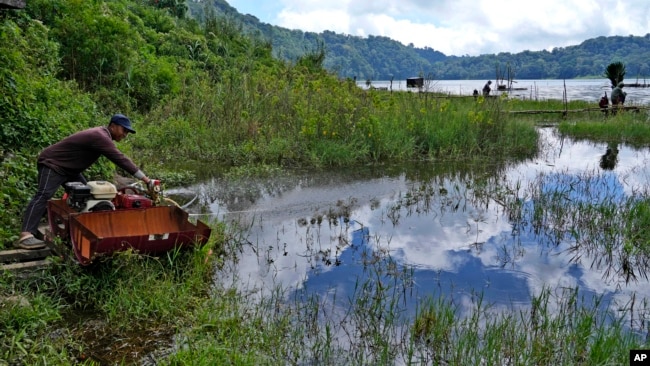何年前になるでしょうか。ケチャダンスを見たくて、バリを訪れました。
その景観の美しさ、自然が息づき、海は美しく煌めき、まさしく私にとってはHEVENでした。当時はまだホテルも少なく、またホテルから一歩外に出れば、単車が土埃を巻き上げ走っていました。
たった7〜8年でそれほどの開発がバリから豊かさを奪ってしまっていたなんて思ってもいませんでした。
この記事を聞いていて、天の川を見たくて、ニュージーランドのテポカを訪れたときのことを思い出しました。夜空の星々が観光スポットの街なので、ホテル・店舗合わせて数軒のみ。照明も落としての営業です。ですから夜は本当に真っ暗!!ホテル前のお芝生に寝転がれば、さっき見てきた展望台と同じ星々が降り注いでいました。
観光が重要な財源になることは同じですが、自然、景観、暮らしを守りながら破壊では開発をしている国はあるのです。
だって、また行きたい場所なのですから。あの自然い会いに♡Bali
VOAで英語を学びましょう!!
インドネシアのバリ島を脅かす水の危機(和訳)
Water Crisis Threatens Indonesia’s Bali
December 18, 2022
インドネシア・バリ島は、観光開発、人口増加、水の不適切な管理により、水危機の深刻化に直面しています。水不足はすでにユネスコ世界遺産の建造物や食料生産、バリの文化に影響を及ぼしています。
専門家は、既存の水管理政策が島中で実施されなければ、状況はさらに悪化すると警告しています。
「農家として畑で働くことはもはや不可能です」と、農家であるアイ・ケトゥット・ジャタさんはと話します。土地は乾燥しすぎていて、家族のために売る米を作ることができないと彼は言っています。
バリ島はインドネシアの島々の中心に位置しています。バリ島は、3つの水源から水を得ています:湖、川、地下水です。”スバック”と呼ばれる伝統的な irrigation system灌漑システムは、水路、ダム、トンネルのネットワークを通じて水を送っています。
スバックは2012年にユネスコの世界遺産に登録されました。このシステムは、バリ文化の中心的なものです。それは、バリ・ヒンドゥー教の教えである、人と、自然と、精神性のharmony調和という考えを表しています。
「これはアジアで生きているlandscapes景観の非常に特別なケースの1つです」とバンコクのユネスコで働くフォン・ジンさんは述べています。
しかし、需要がスバックやその他の水資源に深刻な負担をかけているとプトゥ・バワ氏は言います。彼は、バリ島水質保護プログラムのメンバーです。
バリ島の人口は1980年から2020年の間に70%以上増加し、430万人に達したことが政府のデータで明らかになりました。観光の伸びはさらに大きいです。1980年にこの島を訪れた外国人観光客は14万人未満でした。2019年には、外国人観光客は620万人以上、インドネシア人観光客は1,050万人以上となりました。
バリ島の経済は観光業で非常にうまくいっていますが、その代償は大きいのです。かつてスバックが通っていた水田は、ゴルフ場やウォーターパークになりました。スバックに水を自然に集める森は、新しい住宅やホテルのために破壊された、とバワ氏は言います。
ストロマ・コールさんはロンドンのウェストミンスター大学に所属しています。彼女は観光業がバリの水源に与える影響について研究しています。コールさんは、人々や企業が政府所有の供給源ではなく、私有の井戸を使用しているため、地下水位も下がっていると言います。The water table地下水位とは、岩や土が常に水に囲まれている地表の上層のことです。
バリの地下水位は10年足らずで50メートル以上も下がっている地域があります。特に南部では、井戸が枯れたり、海水で傷んだりしています。
バリ島には、水の使用許可や使用した水に対する税金などのルールがあります。しかし、強制力はないととコール氏は言います。
水危機が深刻なのは、バリ島北西部のジャティルウィです。この地域にはバリ島最大の米作地帯があるのです。
代々、農家は灌漑にスバックシステムを利用してきました。しかし、この19年間、農家は白いプラスチックパイプで水を汲み上げ、畑に灌漑しなければならなくなりました。
バリの農家の中には、水の供給が限られているため、2〜3回ではなく、年に1回しか米の収穫ができないと言う人もいることが、コール氏の調査で分かりました。そのため、島の食糧生産が減少する可能性があります。
パンデミック時にインドネシアが国境を閉鎖すると、バリの観光客は大きく減少しました。環境保護活動家たちは、この閉鎖によって井戸の水位が上がることを期待していました。
しかし、島中の開発は続いており、新しい道路はスバックシステムにさらに影響を及ぼすと活動家たちは指摘しています。新しいホテルや住宅、その他のビジネスも、需要を増やしています。
バワ氏は、観光はバリ島にとって重要だが、島の水資源を守るために、より良い施行と監視の強化が必要であると話します。
「島の存続のために、私たちは一緒に行動する必要があるのです。」
Water Crisis Threatens Indonesia’s Bali
Bali, Indonesia, is facing a worsening water crisis from tourism development, population growth and water mismanagement. Shortages already are affecting UNESCO World Heritage structure, food production and Balinese culture.
Experts warn the situation will worsen if existing water control policies are not enforced across the island.
“It is no longer possible to work in the fields as a farmer," said farmer I Ketut Jata. He said the land is too dry to grow rice which he sells to provide for his family.
Bali is in the center of Indonesia's group of islands. Bali gets its water from three main sources: lakes, rivers and groundwater. A traditional irrigation system, called the “subak”, sends water through a network of waterways, dams and tunnels.
The subak was named a UNESCO World Heritage site in 2012. The system is central to Balinese culture. It represents the Balinese Hindu idea of harmony between people, nature and spirituality.
“This is one of the very special cases of living landscapes in Asia,” said Feng Jing, who works with UNESCO in Bangkok.
But demand is putting severe pressure on the subak and other water resources, said Putu Bawa. He is with the Bali Water Protection program.
The island’s population increased by more than 70 percent from 1980 to 2020, to 4.3 million people, found government data. Tourism growth has been even greater: Less than 140,000 foreign visitors came to the island in 1980. By 2019, there were more than 6.2 million foreign and 10.5 million Indonesian tourists.
Bali's economy has done very well with tourism, but at a cost. Rice fields where the subak once ran through have been turned into golf courses and water parks. Forests that naturally collect water for the subak have been destroyed for new homes and hotels, Bawa said.
Stroma Cole is with the University of Westminster in London. She has researched tourism's impact on Bali's water supplies. Cole said the water table is also dropping because people and businesses use private wells instead of government-owned supplies. The water table is the upper level of an underground surface in which rocks or soil are always surrounded by water.
In less than 10 years, Bali’s water table has sunk more than 50 meters in some areas. Wells are becoming dry or have been damaged with salt water, especially in the island's south.
Bali does have rules, like water permits and taxes on water used. They are meant to control the island's water supplies, but there is no enforcement, Cole said.
The serious effect of the water crisis can be seen in Jatiluwih, in northwestern Bali. The area has the island's largest rice farms.
For generations, farmers used the subak system for irrigation. But in the past 19 years, farmers have had to pump water through white plastic pipes to irrigate the fields.
Some Bali farmers say they can only get one rice harvest a year, instead of two or three because of limited water supplies, Cole's research found. That could reduce food production on the island.
When Indonesia closed its borders during the pandemic, Bali's tourism greatly dropped. Environmental activists hoped the closure would help raise water levels in the wells.
But development across the island has continued, including a new road that activists say will further affect the subak system. New hotels, homes and other businesses are also adding to the demand.
Bawa said tourism is important to Bali but there also should be better enforcement and increased monitoring to protect the island's water resources.
“We need to do this together for the sake of the survival of the island."
Words in This Story
tourism — n. the activity of traveling to a place for pleasure
irrigation — n. to supply with water by using artificial means
tunnel— n. a passage that goes under the ground, through a hill, etc.
harmony — n. a pleasing combination or arrangement of different things
landscape — n. an area of land that has a particular quality or appearance
monitor — v. to watch, observe, listen to, or check for a special purpose over a period of time

